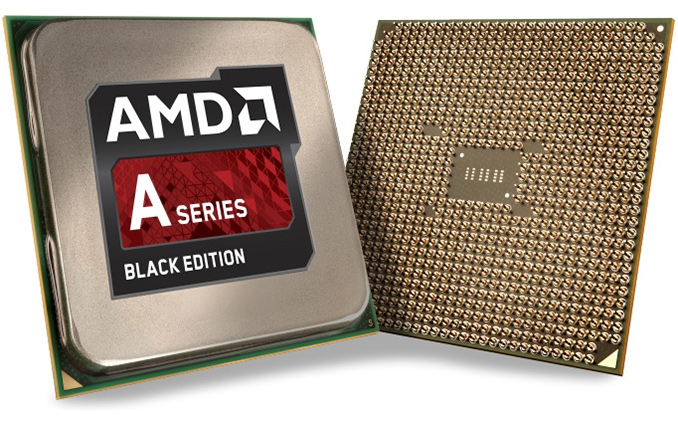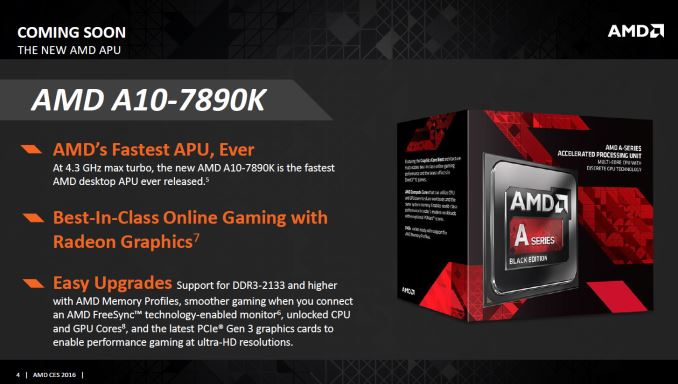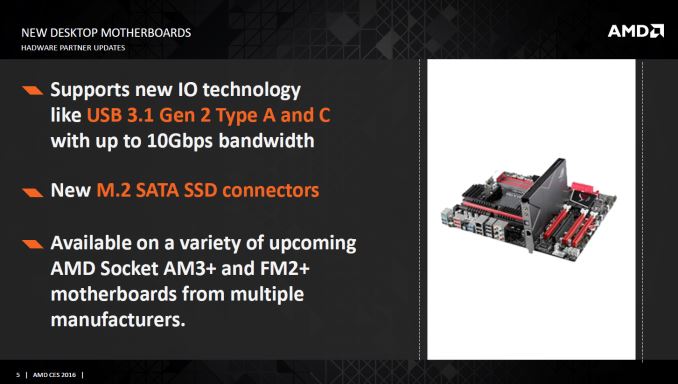AMD Announces A10-7890K APU and Upgrades Desktop Platforms
by Anton Shilov on January 9, 2016 12:22 AM EST
AMD plans to improve performance of its desktop computing platforms by launching a new accelerated processing unit as well as another generation of AM3+ and FM2+ motherboards with USB 3.1 and M.2 ports. The new APU — the AMD A10-7890K — will be the company’s most powerful hybrid processor ever, when it is released later this quarter. The new APU and motherboards will help AMD to maintain its competitive positions.
Same Thing, Only Faster
The upcoming AMD A10-7890K accelerated processing unit is based on the Kaveri design introduced two years ago. The APU will integrate two Steamroller modules (four x86 cores), 4 MB L2 cache, the AMD Radeon R7 integrated GPU with 512 stream processors and GCN 1.1 architecture, a dual-channel DDR3 memory controller (which supports up to DDR3-2133 memory) as well as second-generation video coding engine (VCE) and fourth-generation unified video decoder (UVC) units for video playback. Just like all modern hybrid processors from AMD, the new APU is compatible with heterogeneous system architecture specification 1.0 and can use its graphics core for general-purpose processing (in appropriate applications). The chip will feature unlocked multiplier.
The main difference of the new microprocessor compared to its predecessors will be slightly higher clock-rates and slightly better performance. AMD does not disclose exact specifications of the A10-7890K, but claims that its maximum turbo frequency will be 4.3 GHz, which means that its default clock-rate will likely hit 4 GHz or higher (AMD did not confirm this). It is unclear whether AMD plans to bundle its new Wraith cooler with the A10-7890K, but if the new chip gets the latest cooling solution, then it will get somewhat more competitive.
AMD’s latest APUs for desktops — also known as Godavari — feature upgraded power supply circuitry designed to deliver cleaner and higher amount of power to the die and are made using slightly refined GlobalFoundries’ 28 nm super high performance (SHP) process technology. Improved binning process and increased voltages (compared to the original Kaveri) enable AMD to increase clock-rates of its APUs gradually. This helps the company to sustain average selling price (ASP) of its desktop chips while staying competitive against Intel’s Core i3 and Pentium offerings.
| AMD Kaveri Lineup | |||||||||
| A10- 7890K |
A10- 7870K |
A10- 7850K |
A10- 7800 |
A10- 7700K |
A8- 7670K |
A8- 7650K |
A8- 7600 |
X4 860K |
|
| Modules | 2 | 2 | 2 | 2 | 2 | 2 | 2 | 2 | 2 |
| Threads | 4 | 4 | 4 | 4 | 4 | 4 | 4 | 4 | 4 |
| Core Freq. (GHz) | up to 4.3 | 3.9-4.1 | 3.7-4.0 | 3.5-3.9 | 3.4-3.8 | 3.6-3.9 | 3.3-3.8 | 3.1-3.8 | 3.7-4.0 |
| Compute Units | 4+8 | 4+8 | 4+8 | 4+8 | 4+6 | 4+6 | 4+6 | 4+6 | 4+0 |
| Streaming Processors |
512 | 512 | 512 | 512 | 384 | 384 | 384 | 384 | N/A |
| IGP Freq. (MHz) | unknown | 866 | 720 | 720 | 720 | 754 | 720 | 720 | N/A |
| TDP | 95W | 95W | 95W | 65W | 95W | 95W | 95W | 65W | 95W |
| DRAM Frequency |
2133 | 2133 | 2133 | 2133 | 2133 | 2133 | 2133 | 2133 | 1866 |
| L2 Cache | 2x2MB | 2x2MB | 2x2MB | 2x2MB | 2x2MB | 2x2MB | 2x2MB | 2x2MB | 2x2MB |
The release of the AMD A10-7890K accelerated processing unit may not be a breakthrough in terms of additional performance. However, it shows two important things. Firstly, AMD can increase clock-rates of its existing chips (which potentially means that overclockers can boost them further). Secondly, AMD is confident that its upcoming code-named Bristol Ridge APUs will be powerful enough to leave current-gen hybrid processors behind in terms of performance.
New Motherboards Incoming
AMD also revealed at CES that its partners are working on a new generation of socket AM3+ and socket FM2+ motherboards. The new breed of mainboards from various manufacturers will feature USB 3.1 gen 2 controllers (ASMedia ASM1142) that will enable USB type-A and USB type-C ports. Besides, select motherboards will also have M.2 connectors for solid-state drives.
The implementation of the USB 3.1 is relatively easy: the ASMedia ASM1142 controller requires two PCI Express 2.0 lanes (something that all modern AMD platforms have), everything that motherboard makers need to do is to install one chip and supporting logic. Meanwhile, a properly implemented M.2 connector for contemporary solid-state drives needs four PCI Express 3.0 lanes in order to provide up to 3940 MB/s of bandwidth. The AMD FX (AM3+) platforms do not support PCIe 3.0 natively at all, hence, AMD’s partners will have to either implement an M.2 connector using four PCIe 2.0 ports (which would limit bandwidth to 2000 MB/s), or use a PCIe switch to “convert” eight PCIe 2.0 lanes into four PCIe 3.0 lanes. The AMD A-series (FM2+) processors support PCIe 3.0 x16 and hence can support an M.2 port with PCIe 3.0 x4 bandwidth, but in that case graphics cards will have to work in PCIe 3.0 x8 mode. In general, it is possible to add USB 3.1 and M.2 to current-generation AM3+ and FM2+ platforms, but that comes at a cost.
Waiting for Next-Generation
Without any doubts, higher clock-rates and better feature-set will make AMD-based platforms faster and more compelling. Unfortunately, a minor increase in frequency as well as addition of the USB 3.1 and the M.2 to several new motherboards will hardly dramatically increase popularity of AMD’s A-series or FX-series microprocessors. Nonetheless, proper pricing and up-to-date features will help AMD to maintain its positions.
What the market is waiting for is the next-generation AMD platform that is based on the company’s microprocessors code-named Summit Ridge. The CPU developer hopes that its Zen micro-architecture will deliver 40% higher IPC (instructions per clock) performance compared to the predecessor, whereas new 14nm/16nm FinFET process technologies will help to lower power consumption and/or increase clock-rates.












59 Comments
View All Comments
KatherineShort - Saturday, January 9, 2016 - link
The company has also just revealed the A10-7890K APU, which offers a small speed increase over the current flagship APU from AMD, the A10-7870K.http://aimsely.com
ddriver - Saturday, January 9, 2016 - link
Too bad in AMD's case all references to "faster" outta be revisited to "less slow"nathanddrews - Saturday, January 9, 2016 - link
Can't these all be overclocked to about the same freq anyway?Alexvrb - Saturday, January 9, 2016 - link
Depends. The binning process often makes it more likely to get better results out of a chip that is clocked higher from the factory while sticking to the same voltage/TDP. Though market demand doesn't always match bin results and that's part why that doesn't always hold true. Long story short yes and no, chip lottery yada yada. :PStevoLincolnite - Saturday, January 9, 2016 - link
Usually AMD and Intel give you more voltages than is actually needed in order to have the largest possible amount of chips for each bin.However... As you become more stringent with the Voltages/TDP/Frequency testing in order to have higher binned chips... Then your testing costs and time also increases.
Majority of APU's can hit this frequency without much of a problem though, in-fact most can surpass it, but you also have the GPU to consider, varying models have differing amounts of GPU hardware.
But with that said... These chips aren't going to be beating a heavily overclocked Phenom 2 x4 from 7 years ago, at 4.0 - 4.2ghz with a 3ghz NB clock the Phenom's would have the edge, at-least in terms of performance anyway.
I would rather get a 95w Thuban hex and drop in a cheap discreet radeon than one of these APU's, would be cheaper and faster, but that's just me. :p
extide - Saturday, January 9, 2016 - link
These could be the result of an improved process, or perhaps even a slightly revised chip. So, there might be a bit more headroom in these chips.Wolfpup - Friday, January 15, 2016 - link
It's not as fast as Intel's best, but that's not the same thing as saying it's "slow". It's crazy fast by any other standards, and better than what more people are actually running.rocketscience315 - Saturday, January 9, 2016 - link
While less exciting than the new micro-architectures, I hope the consideration of M.2 and USB3.1 will mean that the Ridge series will include these in the next North/South-bridge/FCH.Arnulf - Saturday, January 9, 2016 - link
I don't want higher core voltage!??This product makes very little sense in lieu of upcoming Excavator based APUs for AM4 on same 28 nm process (due in 2016) and Zen based 14 nm ones (due in 2017). Those who already own a FM2+ APU won't get much of an upgrade over existing chips and those looking for a new features would be better off moving to AM4 because of its faster memory interface (which is crucial for APUs).
zodiacfml - Saturday, January 9, 2016 - link
It makes sense in a way it is a stopgap for 2017 products which should be released this year.